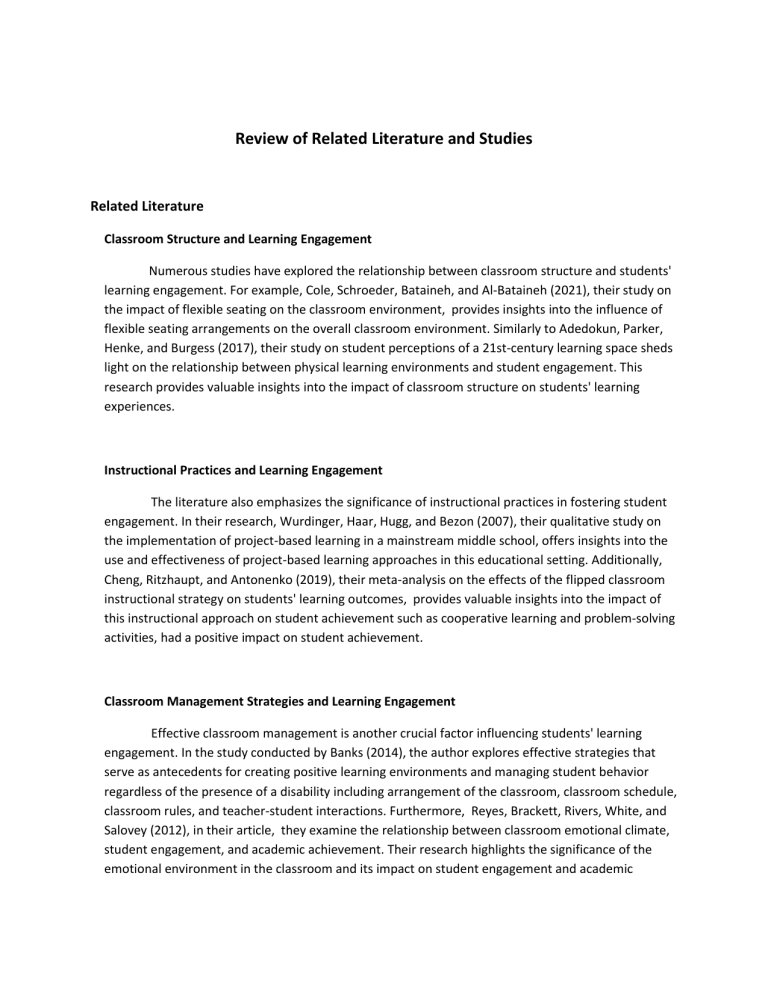
Review of Related Literature and Studies Related Literature Classroom Structure and Learning Engagement Numerous studies have explored the relationship between classroom structure and students' learning engagement. For example, Cole, Schroeder, Bataineh, and Al-Bataineh (2021), their study on the impact of flexible seating on the classroom environment, provides insights into the influence of flexible seating arrangements on the overall classroom environment. Similarly to Adedokun, Parker, Henke, and Burgess (2017), their study on student perceptions of a 21st-century learning space sheds light on the relationship between physical learning environments and student engagement. This research provides valuable insights into the impact of classroom structure on students' learning experiences. Instructional Practices and Learning Engagement The literature also emphasizes the significance of instructional practices in fostering student engagement. In their research, Wurdinger, Haar, Hugg, and Bezon (2007), their qualitative study on the implementation of project-based learning in a mainstream middle school, offers insights into the use and effectiveness of project-based learning approaches in this educational setting. Additionally, Cheng, Ritzhaupt, and Antonenko (2019), their meta-analysis on the effects of the flipped classroom instructional strategy on students' learning outcomes, provides valuable insights into the impact of this instructional approach on student achievement such as cooperative learning and problem-solving activities, had a positive impact on student achievement. Classroom Management Strategies and Learning Engagement Effective classroom management is another crucial factor influencing students' learning engagement. In the study conducted by Banks (2014), the author explores effective strategies that serve as antecedents for creating positive learning environments and managing student behavior regardless of the presence of a disability including arrangement of the classroom, classroom schedule, classroom rules, and teacher-student interactions. Furthermore, Reyes, Brackett, Rivers, White, and Salovey (2012), in their article, they examine the relationship between classroom emotional climate, student engagement, and academic achievement. Their research highlights the significance of the emotional environment in the classroom and its impact on student engagement and academic outcomes, where students feel safe, respected, and valued, in promoting engagement and academic success. Related Studies A Study on Classroom Structure and Student Engagement According to, Virtanen, Lerkkanen, Poikkeus, and Kuorelahti (2015) investigated the relationship between classroom quality and students' engagement in secondary school. In their study published in Educational Psychology, they examined how the quality of the classroom environment impacts student engagement. The research findings emphasize the importance of creating a positive and supportive classroom atmosphere that fosters student engagement and academic success (Virtanen et al., 2015).The researchers found that classrooms with flexible seating arrangements and collaborative learning spaces were associated with higher levels of student engagement and active participation in class activities. The study emphasized the importance of creating a conducive physical environment that promotes interaction and student agency. An Examination of Instructional Practices and Student Engagement In a study by Santos, Figueiredo, & Vieira (2019) the researchers examined the impact of instructional practices on student engagement in middle school classrooms. The findings revealed that teachers who implemented student-centered instructional approaches, such as providing opportunities for student choice and promoting active participation, had higher levels of student engagement and academic achievement. The study highlighted the significance of instructional strategies that empower and involve students in their own learning process. Investigating Classroom Management and Student Engagement A study by Hagenauer, Hascher, & Volet (2015). Teacher emotions in the classroom: associations with students’ engagement, classroom discipline and the interpersonal teacher-student relationship.The researchers found that teachers who employed positive behavior management techniques, such as praise, rewards, and clear expectations, had higher levels of student engagement and on-task behavior. The study underscored the importance of proactive classroom management strategies in creating a supportive and engaging learning environment. The review of related literature and studies demonstrates the consistent findings regarding the influence of classroom structure, instructional practices, and classroom management strategies on student engagement. These studies provide valuable insights and serve as a foundation for the current research, which aims to examine the specific relationship between classroom structure and students' learning engagement in Grade 11 at Bondoc Peninsula Agricultural High School.Certainly! Here's a continuation of the review of related literature and studies: Summary The reviewed literature and studies highlight the importance of classroom structure, instructional practices, and classroom management strategies in promoting student engagement in the learning process. Flexibility in seating arrangements, student-centered teaching approaches, and proactive classroom management techniques have consistently been associated with higher levels of student engagement and improved learning outcomes. The findings from these studies suggest that the physical environment of the classroom, the teaching methods employed by educators, and the establishment of a positive classroom climate all play significant roles in shaping students' engagement and motivation to learn. By creating a supportive and interactive learning environment, educators can foster a sense of ownership and active participation among students, leading to enhanced learning experiences. While the reviewed literature provides valuable insights into the relationship between classroom structure and student engagement, there is a need for further research specific to agricultural high schools. The context of Bondoc Peninsula Agricultural High School, with its focus on agricultural education, adds a unique dimension to the study. Investigating how classroom structure influences student engagement in this specific setting can provide valuable information for educators, policymakers, and stakeholders in the agricultural education sector. In the following chapters, this study will build upon the existing literature and studies to examine the current classroom structure at Bondoc Peninsula Agricultural High School, explore students' perceptions of their engagement in the learning process, and identify effective strategies for promoting student engagement in the classroom. Through this research, we aim to contribute to the development of evidence-based educational practices that support the learning and academic success of Grade 11 students at Bondoc Peninsula Agricultural High School. Methodology Research Design This study adopts a case study research design to examine the relationship between classroom structure and student learning engagement in Grade 11 at Bondoc Peninsula Agricultural High School. A case study approach allows for an in-depth exploration of a specific context and provides rich qualitative data to gain insights into the phenomenon under investigation. Locale of the Study The study will be conducted at Bondoc Peninsula Agricultural High School, located in Barangay Sta Rosa, Mulanay Quezon. This school was selected as the research site due to its relevance to the topic of interest and availability of Grade 11 students for data collection. Participants of the Study The participants of this study will consist of Grade 11 students enrolled at Bondoc Peninsula Agricultural High School. A purposive sampling technique will be employed to select participants who have experienced different classroom structures and can provide diverse perspectives on learning engagement. The final sample size will depend on data saturation, ensuring sufficient depth and breadth of information. Data Collection Procedure Data will be collected through a combination of methods to capture a comprehensive understanding of the relationship between classroom structure and student learning engagement. The data collection methods will include: 1. Classroom observations: The researcher will conduct systematic observations of classroom activities, paying attention to the physical environment, seating arrangements, and instructional practices that facilitate student engagement. 2. Surveys/questionnaires: A survey questionnaire will be administered to the Grade 11 students to gather quantitative data on their perceptions of classroom structure and their self-reported levels of learning engagement. The survey will be developed based on established scales and validated instruments. Data Analysis Techniques Data analysis will involve both qualitative and quantitative approaches to gain a comprehensive understanding of the research topic. The qualitative data from observations and questionnaire will be analyzed using thematic analysis to identify patterns and themes related to classroom structure and learning engagement. The quantitative data from surveys/questionnaires will be analyzed using appropriate statistical techniques, such as descriptive statistics and correlational analysis, to examine the relationships between variables. Ethical Considerations Ethical guidelines will be strictly followed throughout the research process. Informed consent will be obtained from participants, ensuring confidentiality and voluntary participation. Participants will be informed about their rights to withdraw from the study at any time without consequences. The research will also adhere to institutional ethical review protocols and guidelines to ensure the protection of participants' rights and well-being.



